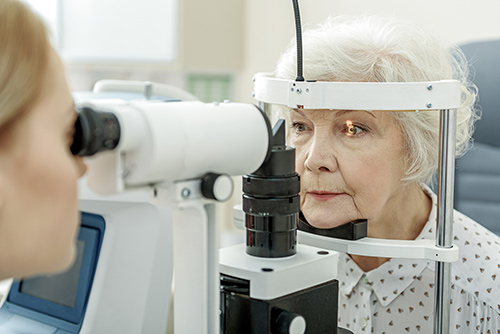2024-07-26 00:00:00Z

Age-related macular degeneration (AMD) is a leading cause of vision loss among adults over the age of fifty, characterized by the gradual deterioration of the macula, the part of the eye responsible for sharp, central vision. AMD typically presents in two forms: dry AMD and wet AMD. Here's a closer look at these conditions, their impact, and why regular eye exams are essential for early detection.
Dry AMD is the more common form, accounting for approximately 80-90% of all AMD cases. It is characterized by the thinning and breakdown of the macula, leading to gradual vision impairment. As dry AMD progresses, tiny yellow deposits called drusen build up under the retina, causing the macula to thin and deteriorate. Over time, this results in a gradual loss of central vision, which can fluctuate and often improves in bright light. In advanced stages, areas of atrophy may become larger, and pre-existing drusen may disappear, leaving behind visible larger choroidal vessels.
Wet AMD, while less common, is more severe and progresses rapidly compared to dry AMD. This form occurs when abnormal blood vessels begin to grow beneath the retina. These blood vessels are fragile and can leak fluid or blood, leading to swelling and damage of the macula. Wet AMD can cause sudden and severe vision loss, making early detection crucial for preventing significant damage.
Many individuals with AMD do not notice any symptoms until the condition has advanced significantly. Common symptoms include blurry or distorted vision, difficulty seeing in low light, and a gradual loss of central vision. Because the macula is responsible for fine details, those with AMD might struggle with activities like reading or recognizing faces.
The condition often goes unnoticed in its early stages, making regular eye exams vital. An eye care professional can detect AMD before significant vision loss occurs through comprehensive eye exams, including retinal imaging and visual acuity tests.
AMD is most commonly seen in people over fifty and is the leading cause of vision loss in this age group. The risk of developing AMD increases with age, but other factors can also contribute, including:
Family History: Genetics play a role, as AMD can run in families.
Smoking: Tobacco use is a significant risk factor for AMD.
Diet: A diet lacking in essential nutrients can increase risk.
Sun Exposure: Prolonged exposure to ultraviolet light may contribute to AMD.
Without proper intervention, AMD can progress to blindness, making early detection and management crucial. Regular eye exams are the best way to monitor your eye health and catch AMD early. Early treatment can help slow the progression of the disease and preserve vision.
At VisualEyes Optometrists, we are dedicated to providing comprehensive eye care and support for those dealing with AMD. We offer personalized advice and treatment options to manage and mitigate the effects of age-related macular degeneration.
If you have concerns about AMD or want to learn more about protecting your vision, contact VisualEyes Optometrists for expert advice and eye care services. Schedule your regular eye exam today and take proactive steps to safeguard your vision and overall eye health.
(703) 417-9316
(703) 671-1188
(703) 764-3937
(703) 804-0355
(Pentagon ID Holders Only)
5876 Kingstowne Center Alexandria, VA 22315
Visit Website Make Appointment4018 Campbell Avenue Arlington, VA 22206
Visit Website Make Appointment9600 H. Main Street Fairfax, VA 22031
Visit Website Make Appointment1 South Rotary Road, STE 2C113
Arlington VA 22202
(For Authorized Pentagon Personnel Only)
Copyright 2025 VisualEyes Optometry. All rights reserved. Website Designed and Maintained by WSI Pro Marketing.
